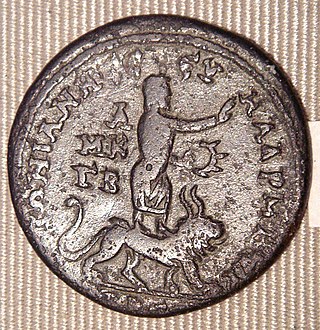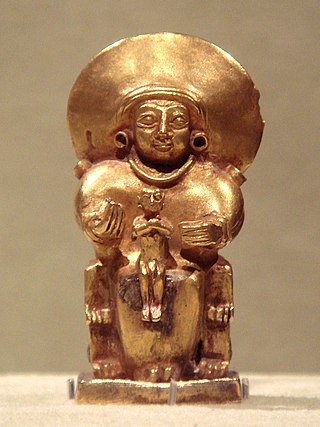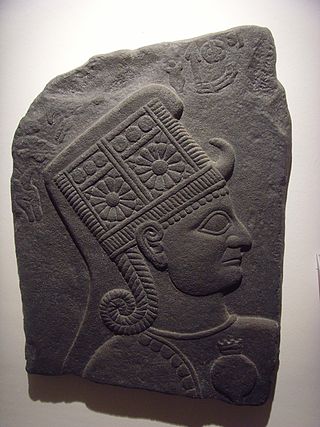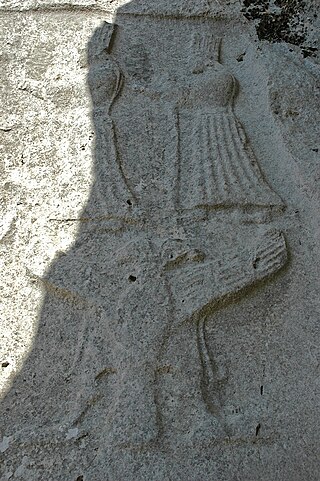
Tiwaz (stem: Tiwad-) was the Luwian Sun-god. He was among the most important gods of the Luwians.

Tiwaz (stem: Tiwad-) was the Luwian Sun-god. He was among the most important gods of the Luwians.
The name of the Proto-Anatolian Sun god can be reconstructed as *Diuod-, which derives from the Proto-Indo-European word *dei- ("shine", "glow"). [1] This name is cognate with the Greek Zeus, Latin Jupiter, and Norse Tyr. While Tiwaz (and the related Palaic god Tiyaz) retained a prominent role in the pantheon, the Hittite cognate deity, Šiwat was largely eclipsed by the Sun goddess of Arinna, becoming a god of the day, especially the day of death.
In Luwian cuneiform of the Bronze Age, his name appears as Tiwad-. It can also be written with the Sumerogram d UTU ("God-Sun"). In Hieroglyphic Luwian of the Iron Age, the name can be written as Tiwad- or with the ideogram (DEUS) SOL ("God-Sun"). [2]
Tiwaz rarely appears in personal names. The oldest example derives from 19th century BC Kültepe, a person called "Tiwatia". [3] The hieroglyphic Luwian name Azatiwada ("Beloved of Tiwaz") is the root of the Pamphylian town of Aspendos. The local name of the town, according to the legends on its coins was Estwedi- (ΕΣΤϜΕΔΙΙΥ). Unlike other Luwian gods' names, Tiwaz is not attested in southern Anatolian personal names of the Hellenistic period. A Lycian women's name, Tewidarma (Τευδιαρμα; "Sun-Moon") and a Lydian patronym, Tiwdalis, are derived from Tiwaz.
The name also appears in ḪUR.SAGTiwatašša, the Hittite name for a mountain located somewhere in southwestern Anatolia.
Tiwaz was the reflex of the male sky god of the Indo-European religion, Dyeus, who was superseded among the Hittites by the Hattian Sun goddess of Arinna.
In Bronze Age texts, Tiwaz is often referred to as "Father" (cuneiform Luwian: tatis Tiwaz) and once as "Great Tiwaz" (cuneiform Luwian: urazza-dUTU-az), and invoked along with the "Father gods" (cuneiform Luwian: tatinzi maššaninzi). His Bronze Age epithet, "Tiwaz of the Oath" (cuneiform Luwian: ḫirutalla-dUTU-az), indicates that he was an oath-god. In this role he received sacrifices of sheep, red meat and bread. The Luwian verb tiwadani- ("to curse") is derived from Tiwaz's name.
According to Hittite sources, Tiwaz and Kamrušepa were the parents of the tutelary god of Tauriša . Like Kamrušepa, Tiwaz is closely associated with sheep. The god Hapantali, who worked with Kamrušepa in purification rituals, looked after his sheep in the myth of Telipinu. [4] His followers include the Ilaliyanteš , who generally appear in bad situations.
In the Hittite and Hurrian religions the Sun goddess of the Earth played an important role in the death cult and was understood to be the ruler of the world of the dead. For the Luwians there is a Bronze Age source which refers to the "Sun god of the Earth" (cuneiform Luwian: tiyamašši-dU-za): "If he is alive, may Tiwaz release him, if he is dead, may the Sun god of the Earth release him" (Boğazköy cuneiform inscription, 35.48 ii 19.23).
There are no known Bronze Age depictions of the Luwian Sun god. There are two reliefs from the Iron Age, which show Tiwaz with the moon god Arma. He is marked out by a winged sun above his head. The image from Arslantepe closely resembles the depiction of the Sun god from the Hittite sanctuary at Yazılıkaya.

Luwian, sometimes known as Luvian or Luish, is an ancient language, or group of languages, within the Anatolian branch of the Indo-European language family. The ethnonym Luwian comes from Luwiya – the name of the region in which the Luwians lived. Luwiya is attested, for example, in the Hittite laws.
Palaic is an extinct Indo-European language, attested in cuneiform tablets in Bronze Age Hattusa, the capital of the Hittites. Palaic, which was apparently spoken mainly in northern Anatolia, is generally considered to be one of four primary sub-divisions of the Anatolian languages, alongside Hittite, Luwic and Lydian.
Kamrušepa was a Hittite and Luwian goddess of medicine and magic, analogous to Hattic and Palaic goddess Kataḫzipuri. She is best known as one of the deities involved in the Telepinu Myth, in which her actions were crucial to pacify the anger of the "missing" vegetation god.

Hittite mythology and Hittite religion were the religious beliefs and practices of the Hittites, who created an empire centered in what is now Turkey from c. 1600–1180 BC.
The Luwians were an ancient people in Anatolia who spoke the Luwian language. During the Bronze Age, Luwians formed part of the population of the Hittite Empire and adjoining states such as Kizzuwatna. During the Hittite New Kingdom, Luwian replaced Hittite as the empire's dominant language. In the early Iron Age, a number of Luwian-speaking Neo-Hittite states arose in northern Syria. The Luwians are known largely from their language, and it is unclear to what extent they formed a unified cultural or political group.

Šanta (Santa) was a god worshiped in Bronze Age Anatolia by Luwians and Hittites. It is presumed that he was regarded as a warlike deity, and that he could additionally be associated with plagues and possibly with the underworld, though the latter proposal is not universally accepted. In known texts he frequently appears alongside Iyarri, a deity of similar character. He is first attested in documents from Kanesh dated to the Old Assyrian period, and continues to appear in later treaties, ritual texts and theophoric names. He is also present in an offering lists from Emar written in Akkadian, though he did not belong to the local pantheon and rituals involving him were only performed on behalf of the Hittite administration by local inhabitants.
Ḫapantali, also known as Ḫapantaliya, was a Luwian goddess who functioned as a divine shepherd. She was also incorporated into Hattian and Hittite beliefs. She is first attested in the Old Assyrian period, and later continued to be worshiped until the fall of the Hittite Empire. She appears in a variety of texts, including descriptions of festivals, treaties, and myths. While in ritual texts she was often linked with Inar, in mythological context she instead could be designated as a helper of Kamrušepa or her husband Tiwad.

Tarḫunz was the weather god and chief god of the Luwians, a people of Bronze Age and early Iron Age Anatolia. He is closely associated with the Hittite god Tarḫunna and the Hurrian god Teshub.

Runtiya was the Luwian god of the hunt, who had a close connection with deer. He was among the most important gods of the Luwians.
Ala was a Hittite and Luwian goddess of the wilderness and partner of the god Runtiya. She played only a minor role in the pantheon.

Arma was an Anatolian Moon god, worshipped by the Hittites and Luwians in the Bronze Age and early Iron Age.

Tarḫunna or Tarḫuna/i was the Hittite weather god. He was also referred to as the "Weather god of Heaven" or the "Lord of the Land of Hatti".
Maliya was a goddess worshiped by Hittites in the Bronze Age. She was most likely a deified river in origin, but she was also associated with gardens and with artisanship, specifically with leatherworking and carpentry. The oldest attestations of her have been identified in the Old Assyrian texts from Kanesh. This city continued to be associated with her in later tradition, though she was also worshiped in Hattusa and elsewhere in the Hittite Empire. She is also present in texts originating in Kizzuwatna, which indicate she had a temple in Kummanni, where she was worshiped alongside various Hurrian deities.

The Sun goddess of Arinna, also sometimes identified as Arinniti or as Wuru(n)šemu, is the chief Goddess of Hittite mythology. Her companion is the weather god Tarḫunna. She protected the Hittite kingdom and was called the "Queen of all lands." Her cult centre was the sacred city of Arinna.
Mezulla or Mezzulla was a minor Hittite goddess. She and her daughter Zintuḫi were closely associated with the Sun goddess of Arinna; together they formed a triple deity. Mezulla had only local importance and is not mentioned in the oath lists of Hittite interstate treaties.

Luwian religion was the religious and mythological beliefs and practices of the Luwians, an Indo-European people of Asia Minor, which is detectable from the Bronze Age until the early Roman empire. It was strongly affected by foreign influence in all periods and it is not possible to clearly separate it from neighbouring cultures, particularly Syrian and Hurrian religion. The Indo-European element in the Luwian religion was stronger than in the neighbouring Hittite religion.

Allanzu, later known under the name Alasuwa, was a Hurrian goddess regarded as a daughter of Ḫepat. She was described as a youthful deity and in known texts often appears in association with her mother and siblings. She was also worshiped by Hittites and Luwians.
Ziparwa, originally known as Zaparwa, was the head of the pantheon of the Palaians, inhabitants of a region of northern Anatolia known as Pala in the Bronze Age. It is often assumed that he was a weather god in origin, though he was also associated with vegetation. Information about the worship of Ziparwa comes exclusively from Hittite texts, though some of them indicate that formulas in Palaic were used during festivals dedicated to him held in Hittite cities such as Hattusa.
Kammamma was a Hattian god worshiped by Hittites and Palaians. He belonged to the category of tutelary deities (DLAMMA) and might have been associated with vegetation. He attained a degree of importance in the Hittite state pantheon in the Old Hittite period, and in some cases he is listed in hierarchically arranged lists directly after Tarḫunna and the sun goddess of Arinna, the main Hittite deities.
The Dark Gods or Dark Ones, also known as the Heptad, were a group of malevolent deities from the religions of the ancient Anatolian peoples.